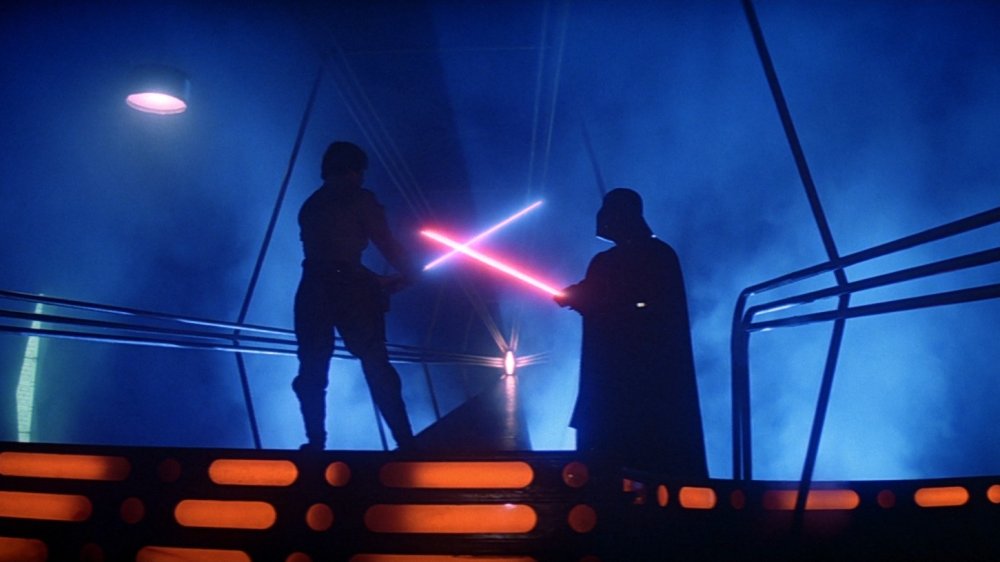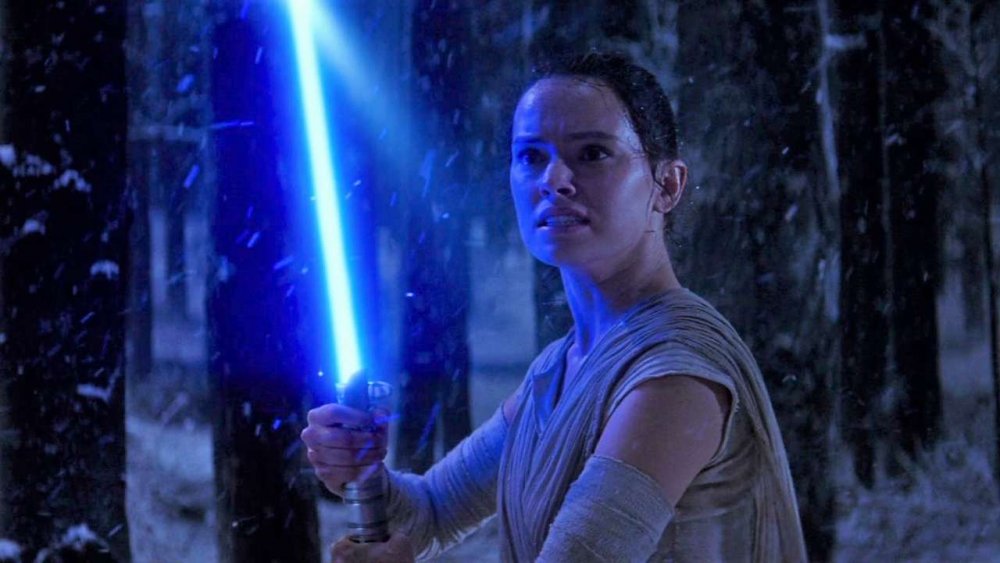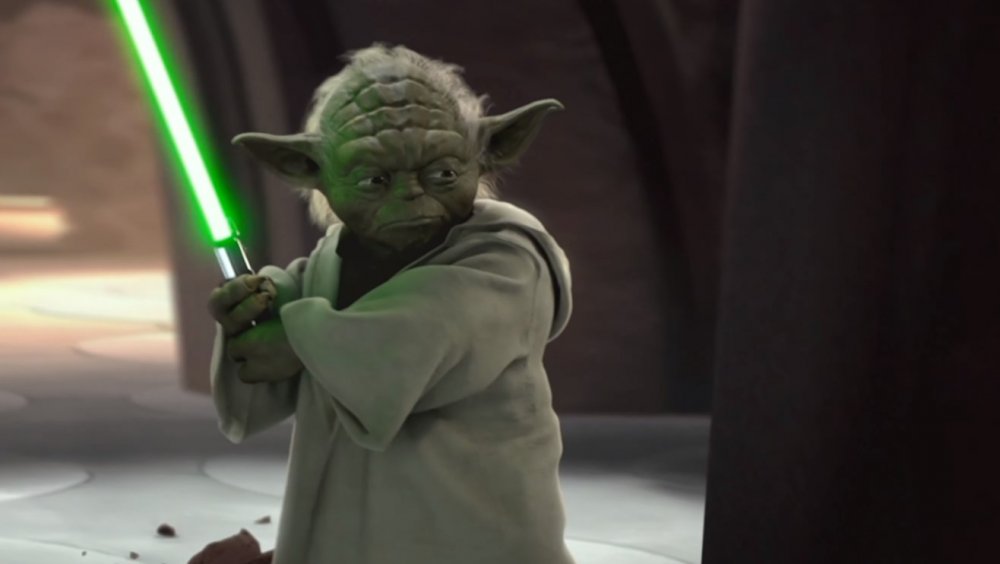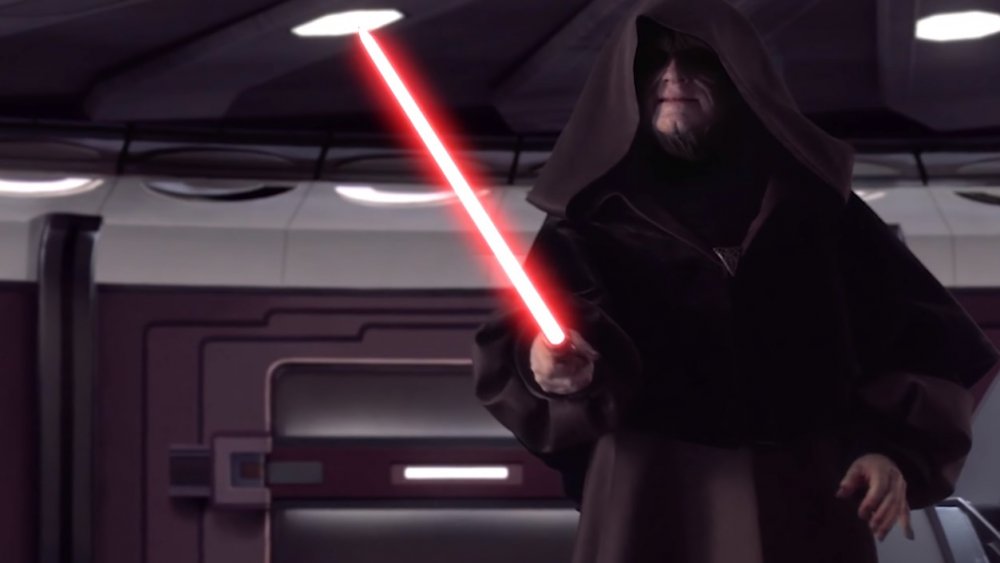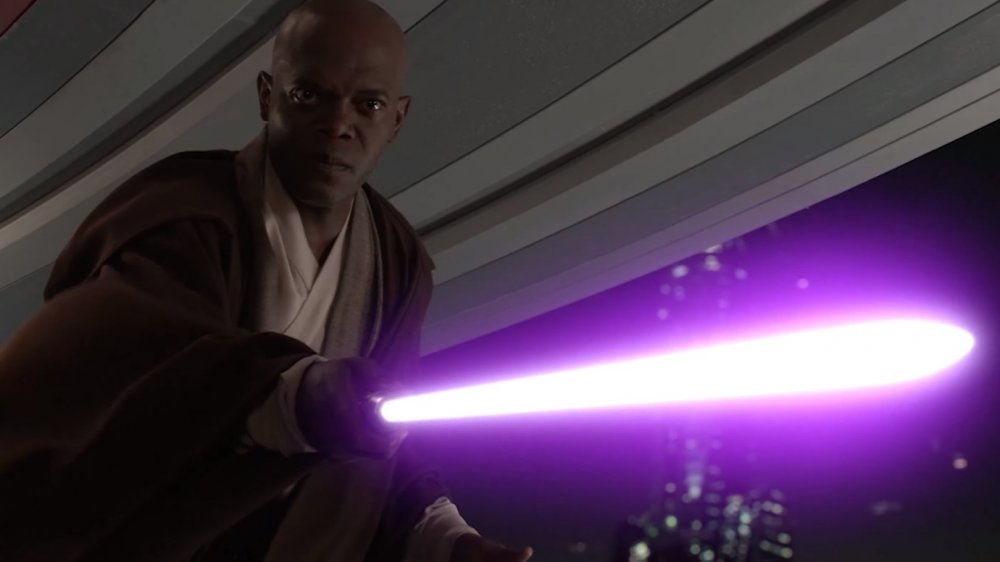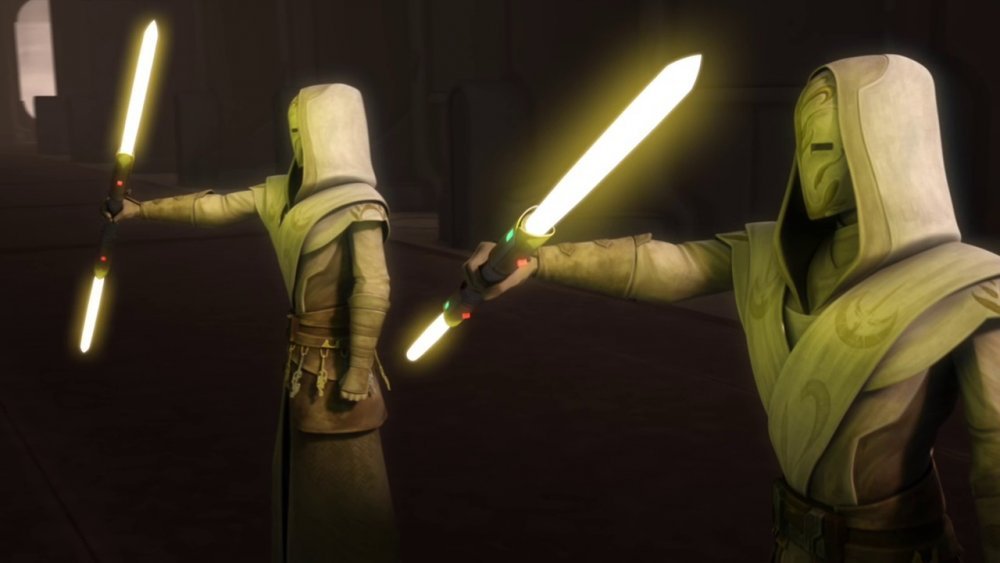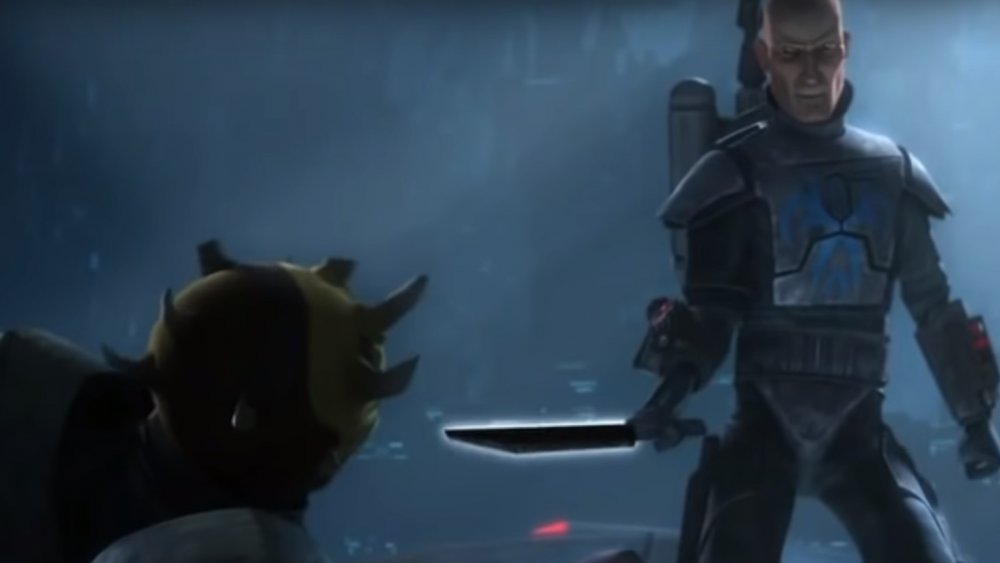The True Meaning Behind Each Lightsaber Color
A long time ago in a movie theater parking lot that's probably within walking distance of where you are right now, there was a discussion that kept the minds of budding young nerds perky. It was a conversation that many of us would echo through our stepdads' basements and the asthmatic kids section of gym class for decades to come. This was the personality marker of a Jedi Knight. Not as random or clumsy as a "Which Hogwarts House Are You In" MySpace quiz, it was a more elegant manner of geeky self-definition from a more civilized age. Aspiring space wizards the world over asked themselves, "What color lightsaber would I have?"
Luckily for them, it turned out that Star Wars was destined to be a franchise worth precisely a kajillion dollars, and with its success came years and years of enthusiasts and professionals alike dissecting its most iconic piece of weaponry. Through stories, games, and nearly 40 years of what unceremoniously became non-canon apocrypha at the hands of Emperor Walt, we've been graced with information on every aspect of the Jedi laser sword, inside and out. Most importantly, as much as is possible, we know which colors are used by which kinds of folks, what they say about the wielder's personality, and whether or not a yellow lightsaber totally makes you a Ravenclaw. From red to blue and everything in between, here's the true meaning behind each lightsaber color.
A primer on lightsabers
A lightsaber, like an exotic pet or a scotch-drunk conversation about your marriage with your parents, is a big responsibility and having one is probably ill-advised. Still, if you have your heart set on owning the Rancor limb-cauterizer from a galaxy far, far away, there are some things you should probably know up front.
A lightsaber generally derives its color from a "lightsaber crystal," either an organic or synthesized mineral formation that focuses the energy of the blade. In some Star Wars stories, finding or creating this crystal is considered a rite of passage for up-and-coming Force users, who will frequently traverse the wildest corners of the galaxy searching for that precious Goldilocks not-too-hot, not-too-imbued-with-unspeakable-evil lightsaber crystal.
The most popular planet for harvesting "kyber crystals," at least for the Jedi, was Ilum, an ice planet, where Padawans were taken for a ritual known as "the Gathering," which was shown in the Star Wars: The Clone Wars episode of the same name. The Sith had other ways of wrapping their mitts around a crystal, but we're getting ahead of ourselves.
What's up with the blue lightsaber?
Your standard blue is a classic for a reason. Iconic, ubiquitous, and the first lightsaber seen being activated on screen in A New Hope, a blue blade is pretty much standard issue for a Jedi.
Back in the day, a long time before "a long time ago," it was established that a blue lightsaber meant the user was a Jedi Guardian, the dance club bouncers of the Jedi order. Remember when Mace Windu said, "We are keepers of the peace, not soldiers?" These guys were pretty much totally soldiers. With their training focused on outer space martial arts and lightsaber tomfoolery, Guardians were noble, robed warrior monks whose arrival heralded a hasty round of limb removal. Jedi Guardians took center stage in the prequel trilogy, with both Obi-Wan and Anakin as members of their ranks.
What does all of this mean? What does it indicate about the person behind the lightsaber? Besides a propensity for space fencing, not a lot. Mostly that the Jedi liked uniformity in their white hot stabbing implements.
Green means a weapon for thoughtful limb-choppers
A green lightsaber was the calling card of the Jedi Consulars, the thinking man's Jedi. Wielded in the films by folks like Qui-Gon Jinn, Yoda, and an older and more self-assured Luke Skywalker, green lightsaber crystals seemed to indicate maturity and thoughtfulness in the people who used them to try and cut people's hands off.
Typically, Jedi Consulars were especially Force sensitive, and they weren't generally down for a donnybrook in the same way that a Jedi Guardian might be. They were the diplomats and scholars of the Jedi Order, focusing on their studies and the subtle art of space mediation. These were the ambassadors, teachers, and probably thoughtful school nurses. Wisdom was their deal.
As for the deeper meaning behind a green saber? Stop us if we're getting too philosophical, but it turns out it's all about what's easy on the eyes. In a Vanity Fair article from 2017, creative exec Pablo Hidalgo said that Luke's Return of the Jedi weapon — the first green lightsaber fans ever saw — was originally blue, but the decision was made to turn it a grassier hue when the filmmakers realized that the azure blade was blending in with the sky too much during outdoor action sequences. To quote Hidalgo, "As much as we like to mythologize why it's green and what that all signifies, sometimes there are very pragmatic filmmaking reasons behind these things."
Red: are we the baddies?
If you see a red lightsaber firing up in a dark alley, a seedy bar, or God forbid, the hallway leading back to the Tantive IV, brother, there's a bad moon on the rise. The red saber crystal is a hallmark of the Sith, the nefarious black hats of the Star Wars canon.
The distinctive red glow of a Sith lightsaber comes from a very particular and characteristically yucky lightsaber construction process. Instead of using an organic, farm-to-table kyber crystal the way that the Jedi do, a Sith will traditionally create a synthetic crystal using a special furnace, as well as, you guessed it, the dark side. Pouring all of their negative emotions into the crystal, the Sith will turn it crimson. Boom. Iconic bad guy weapon.
Of course, a rough start in life doesn't always mean that a crystal is doomed for good. Sometimes they get a shot at a color-based re-branding later down the road. But we'll get to that.
A purple lightsaber is for real men
Purple — it's the universal sign of a hardcore dude. For receipts, please see Prince, Thanos, Grimace, and Mace Windu. And in the Star Wars universe? A purple lightsaber represents a user's connection to both the light side and dark side of the Force, according to a profile on Ultrasabers. A Force user with a violet weapon was generally "aggressive, bold, and daring, leading their comrades fearlessly into battle." It's inspiring stuff, really.
In the real world, which is occasionally even more fun than the one with Jabba the Hutt in it, purple lightsabers apparently exist because the actor playing Mace Windu really, really wanted one since he was going to be in a scene with dozens of other sabers being waved around, and he wanted to be able to clock himself on the big screen, per about a million interviews, including one on the Graham Norton show.
So if you want to know what a lavender laser sword really, truly means? It means that Samuel L. Jackson asked for a purple lightsaber so he could see himself in crowded fight scenes, and George Lucas folded, the way any of us would if Samuel L. Jackson asked us for something. In other words, in an argument between Sam Jackson and George Lucas' vision for his multi-generational space opera, Jules Winnfield wins every time.
Yellow means a rare breed
Oh, we're sorry. You don't think there are yellow lightsabers? You've never seen one in the movies? What is this, amateur hour? Get out of here, and let the grown ups talk.
Now that we've cleared out the cheap seats, a yellow lightsaber was the preferred weapon of the Jedi Sentinel. If you've never seen a Jedi Sentinel, it's probably just because there's one sneaking up behind you right now, getting ready to aggressively negotiate some space justice into your heart with a quick surprise attack.
According to the scholars at Ultrasabers, a Jedi Sentinel took the lightsaber-heavy chocolate tactics of a Guardian and the long-winded peanut butter chattiness of a Consular and tried to make those two great tastes taste great together. They were pragmatists, often picking up life skills outside of Force party tricks, making them pretty great folks to have around. They were also frequently assigned as guards of the Jedi Temple, bunking on Coruscant and sporting two-sided lightsaber pikes with distinctive amber blades.
What's going on with the orange lightsaber?
Even in the long, long, impossibly long list of characters in the extended, pre-Disney purge Star Wars universe, there were a scant few that were waving around orange lightsabers. The most famous example was probably Yaddle, the Yoda-but-a-girl seen for roughly six seconds in The Phantom Menace and then relegated to the pages of officially licensed books and comics. It's been speculated that orange sabers were only owned by Jedi who swore not to use their weapons unless absolutely necessary, and that maybe that's why we never saw them in the movies. Another theory states that they're the result of a red kyber crystal being partially healed, leaving a hint of red behind.
As for the new Star Wars world order under the House of Mouse, an orange saber was first spotted in the promotional material for the 2019 video game Star Wars: Fallen Jedi. Here's what we know from that. A person carrying an orange lightsaber has a void inside them, doomed never to be filled, as a result of the naive trust they continually express by pre-ordering EA games before the reviews come in. Weep for these wretches, for they are beyond the reach of the Force.
White means a true neutral
For the distinguishing connoisseur, we humbly present the white lightsaber. It is striking. It is elegant. It looks like a yellow lightsaber that got covered in Crest strips.
Rare even by fictional weapon standards, the white lightsaber borders on unique. In the current canon, the pearly limb fryers first showed up thanks to Ahsoka Tano, Anakin's old Padawan. It's a long story, but Ahsoka wound up leaving the Jedi Order, and then made the infrequently seen career move of not going immediately to the dark side. She wound up sympathetic to the Jedi, but fairly neutral. As laid out in the young adult novel Ahsoka, when she threw down with a Sith-affiliated Jedi hunter and came out on top, she nabbed the red kyber crystals out of his lightsaber and, through sheer force of mystical moral ambivalence (or maybe the light side of the Force,) "cleansed" them, draining the dark side from them and turning the crystals white.
And in case anyone was unclear on the neutrality that the glowing eggshell blades represent, it was flat-out stated by Star Wars: Rebels director Dave Filoni in an interview for the web series Rebels Recon after Ahsoka made her triumphant return to the small screen in the episode "Fire Across the Galaxy."
It's a long story when it comes to black lightsabers
For the Jedi with a lot of feelings, a lot of Abbath T-shirts, or just a love of carrying a weapon that, chromatically, goes with everything, there's the black lightsaber. This puppy right here? It's one of a kind, at least until the Star Wars writers change their minds in a couple of years.
The "Darksaber" isn't just your everyday Jedi weapon. It was the saber of one Tarre Vizsla, the first Mandalorian Jedi. Mandalorians were pretty famous during the Old Republic time period for their enthusiasm about murdering Jedi, so a black lightsaber was just the tip of the counterintuitive iceberg for old Tarre.
The Darksaber wound up being handed down from warrior to warrior throughout the millennia, eventually being used in battles with all of the usual suspects: Obi-Wan, Darth Maul, and even Emperor Palpatine. According to the Mandalorians, the only way to legitimately claim the blade for yourself was to kill the person who had it before you, making the weapon's history a metaphorical barrel of monkeys made out of death. Wielding it makes you not just a certified bad mamajama, but also a murderer. Fun!
All the other kinds of lightsabers
While the colors listed above constitute the lightsabers currently present in the official Star Wars continuity, they don't even scratch the surface of the different variations present in the now-apocryphal Star Wars Legends books, games, and comics.
To the surprise of absolutely nobody, it seems like just about every creative mind tasked with telling a Star Wars story over the last 40-odd years has come up with their own distinctive look for a lightsaber. There are nearly a hundred different documented lightsaber colors listed on the fan-driven Wookieepedia, spanning from the slightly different to the bizarre. As for a few highlights, Lowbacca, one of the few Wookiee Jedi, had a bronze-colored blade. A human Force user named Solimon Dambrizi, featured in Star Wars: The Roleplaying Game, made Will Ferrell proud by constructing a burgundy saber. Raynar Thul, a prominent character in the Star Wars novels, was seen with both gold- and pewter-colored sabers. Really, just about any color you can imagine (with the tragic exception of beige) is yours for the claiming once you start down the Jedi path.

